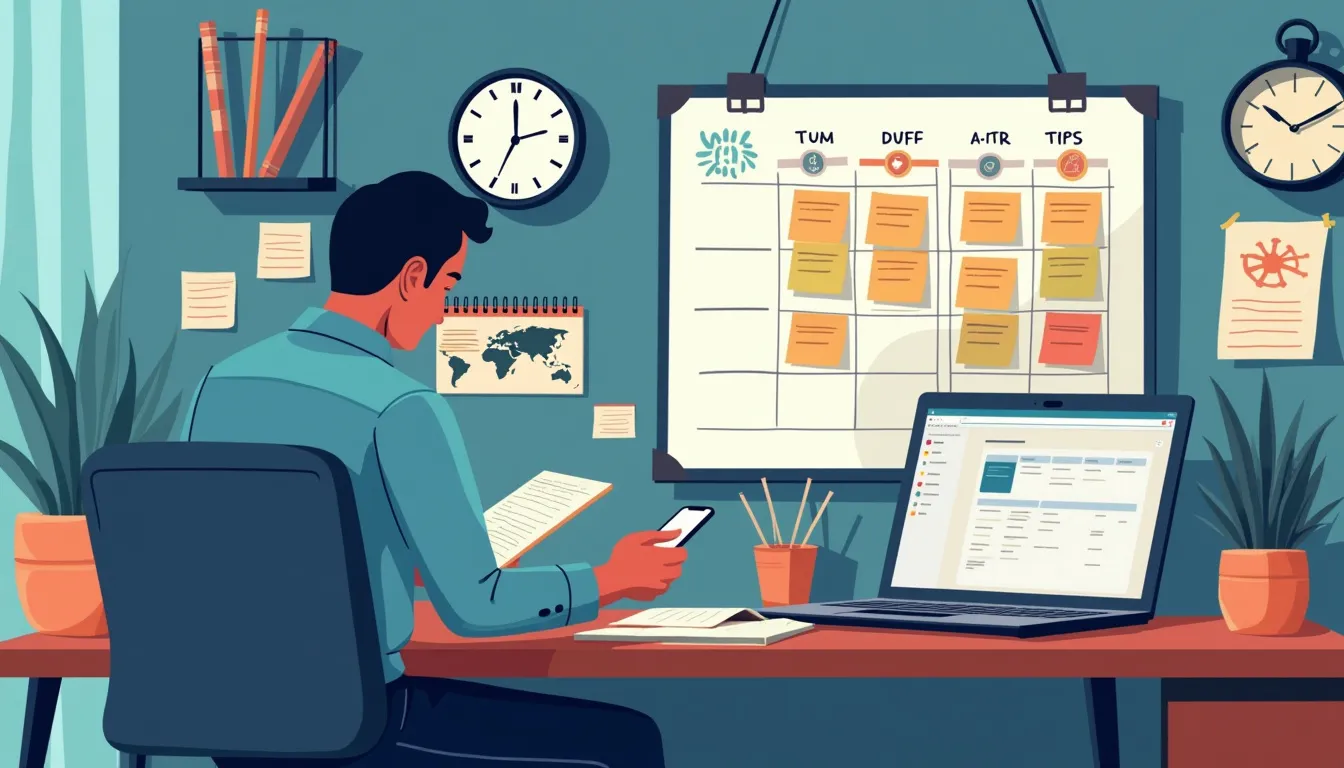In our fast-paced world, finding the equilibrium between professional obligations and personal well-being has become more crucial than ever. Balancing personal life and business is not just a lofty ideal but a necessary pursuit for sustained success and happiness. For entrepreneurs and professionals, the challenges are plentiful; the constant demands on time, coupled with the pressure to perform, can create a tumultuous environment where personal needs often take a backseat. I understand these struggles firsthand—navigating the landscape of a demanding professional life while managing personal challenges such as ADHD, OCD, and weight loss has taught me invaluable lessons in resilience and strategy.
Throughout this article, we will explore effective strategies to enhance this balance. By delving into proven prioritization and time management techniques, we can uncover practical methods to set clear priorities, utilize time-blocking, and ensure that downtime is not just an afterthought but a scheduled necessity. The use of various tools and apps can streamline these efforts, enabling greater efficiency and less stress.
Additionally, we’ll examine the importance of building a robust support system. The role of family and friends cannot be understated in maintaining balance, and networking with like-minded professionals provides a community of support. Learning to delegate and trust your team is also key, along with seeking professional guidance or mentorship when needed.
Finally, self-care and mental health are critical components of a balanced life. Incorporating daily habits that promote physical and mental well-being, mastering stress management techniques, and dedicating time to hobbies and leisure activities can significantly improve one’s quality of life. Recognizing the signs of burnout and taking proactive steps to address it is essential for long-term viability and growth.
Embarking on this journey is not without its challenges. However, with the right strategies and a commitment to personal well-being, achieving a harmonious balance between personal life and business is not just possible—it is within reach. So, let’s dive in and transform how we approach this delicate, yet vital, equilibrium.
Introduction to Balancing Personal Life and Business
In today’s high-paced, always-connected world, balancing personal life and business has become not just a luxury but a necessity for professionals and entrepreneurs alike. The significance of attaining this balance cannot be overstated as it directly impacts both personal well-being and professional success.
Importance of Balance in Modern-Day Living
The modern-day professional faces a unique challenge—juggling multiple roles and responsibilities. Whether you’re a thriving entrepreneur or a dedicated employee, balancing personal life and business is essential for preventing burnout and sustaining long-term productivity. When diligently addressed, a balanced life offers numerous benefits, including enhanced mental clarity, better decision-making, and improved relationships.
Challenges Faced by Entrepreneurs and Professionals
Entrepreneurs and professionals often encounter specific challenges while trying to achieve this balance. For example, the pressure to meet business targets, continuous deadlines, and the pursuit of personal goals can often seem overwhelming. Personally, dealing with ADHD and OCD has posed unique hurdles in managing these aspects concurrently. These conditions necessitate more structure and discipline, which, though challenging, is absolutely achievable with the right strategies.
Moreover, the advent of digital technology, while beneficial, has blurred the lines between work and personal time. Emails, Slack messages, and project updates can follow us home, making it challenging to switch off “work mode.” What compounds these issues even further is the societal expectation to consistently perform and succeed, often at the expense of personal well-being.
Brief Overview of Strategies to Be Discussed
Despite these challenges, there are tried-and-true strategies for balancing personal life and business effectively:
- Prioritizing and Time Management Techniques: This can include setting clear priorities, utilizing time-blocking methods, recognizing the importance of scheduling downtime, and leveraging various tools and apps for efficient time management.
- Building a Support System: The role of family, friends, and professional networks is crucial. Delegating tasks effectively, trusting your team, and seeking mentorship or professional guidance also play critical roles.
- Self-Care and Mental Health: Establishing daily habits for physical and mental well-being, adopting stress management techniques, indulging in hobbies and leisure activities, and recognizing burnout signs are essential for overall health.
Stay tuned as we delve deeper into each of these strategies in the upcoming sections, providing actionable advice, real-life examples, and practical tips to help you master the art of balancing personal life and business.

Prioritizing and Time Management Techniques
In the fast-paced world of entrepreneurship and professional landscapes, balancing personal life and business often feels like walking a tightrope. However, with the right prioritizing and time management techniques, it is feasible to achieve a harmonious balance that benefits both your personal and professional domains.
Setting Clear Priorities for Personal and Business Tasks
One of the foundational steps in balancing personal life and business is setting clear priorities. It’s essential to distinguish between what is urgent and what is truly important. Often, we get caught up in the tyranny of the urgent, at the expense of the essential. To combat this, start by creating a list of both personal and professional tasks. Rank them in order of importance and urgency. For example, attending a child’s school event might take precedence over a non-essential business meeting, while a critical project deadline would trump a casual dinner plan.
Speaking from experience, managing ADHD has made prioritization imperative. Breaking down tasks into smaller, manageable chunks can make it easier to stay on track. Tools like Eisenhower’s Matrix—a method that categorizes tasks into four quadrants based on urgency and importance—can greatly assist in maintaining focus, reducing the overwhelm that often accompanies an extensive task list.
Utilizing Time-Blocking Methods
Time-blocking is a dynamic method utilized by many successful professionals to ensure they allocate dedicated time slots to specific activities. By assigning a fixed duration to different tasks, you prevent work from bleeding into personal time and vice versa. This method promotes a structured day, making room for both productivity and personal fulfillment.
For instance, I often allocate early mornings for strategic work—when my mind is most focused—followed by blocks for meetings and collaborative tasks in the later morning and afternoon. By the evening, I reserve time for family and personal relaxation. This disciplined approach ensures that each aspect of my life receives the attention it deserves, minimizing the risk of burnout.
Importance of Scheduling Downtime
While the allure of continuous productivity is strong, especially under the pressure to achieve business growth, scheduling downtime is crucial. Downtime isn’t a waste; it’s a necessary component of sustained performance. For individuals like myself, who battle OCD and the obsessive need to overwork, consciously scheduling breaks can be a challenge but a vital one.
Consider implementing regular breaks throughout the day—be it a short walk, a quick workout, or simply a cup of coffee away from your work desk. Weekly, ensure you have time blocked off for activities that rejuvenate you, such as hobbies or spending time with loved ones. The benefits are two-fold: enhancing your productivity during work hours and bolstering your overall well-being.
Tools and Apps for Efficient Time Management
In this digital age, a plethora of tools and apps can aid in better managing your time and priorities, making the task of balancing personal life and business much more attainable. Popular choices include Trello, Asana, and Todoist for task management. These platforms allow you to organize, delegate, and track progress efficiently.
For individuals managing conditions like ADHD or OCD, tools with simple, visual interfaces can be particularly effective. For instance, Trello’s card system visually categorizes tasks, making it easier to see what requires attention. Combine this with calendar tools like Google Calendar or Microsoft Outlook, which allow for seamless integration and reminders, ensuring you never miss a crucial personal or professional commitment.
Additionally, apps focused on mindfulness and mental clarity, such as Headspace or Calm, can also play a significant role. They help you incorporate brief moments of reflection and mindfulness into your day, complementing your time management strategies by maintaining mental health.
Ultimately, mastering prioritization and time management is an art form that requires continuous refinement. It involves understanding your unique needs and challenges and being willing to adapt strategies until you find the perfect balance. By setting clear priorities, utilizing time-blocking methods, scheduling essential downtime, and leveraging modern tools effectively, you place yourself on a path to not just balancing personal life and business, but thriving in both.

Building a Support System
In the quest for balancing personal life and business, the importance of building a robust support system cannot be overstated. A strong network of family, friends, and professional connections can be a game-changer, offering both emotional support and practical assistance. Let’s delve into the key elements that contribute to an effective support system.
Role of Family and Friends in Maintaining Balance
Family and friends are often the backbone of our personal lives, providing a haven of stability and encouragement. For many professionals and entrepreneurs, open communication with loved ones is paramount. Sharing your goals, challenges, and milestones helps them understand your journey and offers you a safety net when things get tough. Personally, my journey managing ADHD and OCD has been significantly eased by the unwavering support of my family. Their understanding and patience have allowed me to focus on my business endeavors without feeling overwhelmed.
Importance of Networking with Like-Minded Professionals
Networking isn’t just about making business connections; it’s also about building a community of like-minded individuals who understand the unique pressures of balancing personal life and business. Engaging in professional groups, attending industry events, and participating in online forums can provide a support network that offers advice, shares resources, and empathizes with your struggles. I recall meeting a fellow entrepreneur at a tech conference who introduced me to AI tools that significantly streamlined my workflow, alleviating some of the pressures and improving my work-life balance.
Delegating Tasks and Trusting Your Team
Many entrepreneurs and professionals struggle with delegating tasks, often fearing that no one else can meet their standards. However, learning to delegate is crucial for maintaining a healthy balance. Trusting your team not only empowers them but also frees you to focus on high-priority tasks and personal time. For instance, when I entrusted the management of daily operations to a reliable team member, it allowed me the mental space to focus on strategic growth and personal well-being, contributing to my weight loss journey.
Seeking Professional Guidance or Mentorship
The journey of balancing personal life and business can be complex, and seeking professional guidance or mentorship can provide invaluable insights. A mentor can offer perspective, share strategies that have worked for them, and provide a sounding board for your ideas and concerns. I’ve had the privilege of working with a mentor who helped me understand the intersection of AI and safety, offering strategies to integrate these into my business effectively while ensuring I had time for my personal life. His advice was instrumental in managing my OCD in high-stress scenarios, offering techniques that balanced my mental load.
Building a support system isn’t just a one-time effort; it’s an ongoing process of nurturing relationships and seeking connections that enrich both your personal and professional life. By leveraging the support of family, friends, peers, and mentors, you are better equipped to navigate the complexities of balancing personal life and business.

Self-care and Mental Health
Daily Habits for Maintaining Physical and Mental Well-being
When it comes to balancing personal life and business, developing daily habits that prioritize your physical and mental well-being is crucial. For instance, starting your day with a routine, such as exercise or mindfulness meditation, can set a positive tone. Engaging in physical activities relieves stress and releases endorphins, making you feel good and more focused. It’s about creating a balance that works for you, ensuring you nurture your body and mind amidst your busy schedule.
Personally, dealing with ADHD and OCD taught me the importance of structured daily routines to keep my mental health in check. Incorporating small but consistent habits, such as taking short breaks during work, practicing deep-breathing techniques, and ensuring a balanced diet, can make a significant difference.
Stress Management Techniques
Entrepreneurs and professionals often face high stress levels, making effective stress management imperative for balancing personal life and business. Techniques such as deep breathing exercises, progressive muscle relaxation, and mindfulness can be extremely beneficial. These scientific methods have been proven to lower cortisol levels and reduce stress.
One technique I find particularly effective involves deep breathing combined with visualization. Imagine a tranquil scene – perhaps a calm beach or a serene mountain. As you breathe deeply through your nose and slowly out through your mouth, visualize the stress leaving your body. This strategy doesn’t just mitigate stress but also enhances focus and productivity.
Importance of Hobbies and Leisure Activities
It’s easy to sideline hobbies when balancing personal life and business, but leisure activities play a pivotal role in maintaining mental health. Hobbies provide a creative and emotional outlet, offering relaxation and a break from routine work pressures. Whether it’s painting, gardening, or playing a musical instrument, investing time in hobbies can rejuvenate your mind.
From personal experience, indulging in my hobby of cycling has been transformative. It’s not just about physical exercise but the mental clarity it brings. Riding through nature trails allows me to clear my mind, brainstorm creative solutions, and return to work with renewed vigor.
Recognizing Burnout and Taking Proactive Steps to Avoid It
Burnout is a prevalent issue in the contemporary business world, where individuals often push themselves to the brink. Recognizing the symptoms – such as constant fatigue, disengagement, and decreased productivity – is the first step in managing and avoiding burnout.
Acknowledging my struggle with weight loss has also made me realize the interconnectedness of physical well-being and mental health. When I recognized the early signs of burnout, I proactively set boundaries, ensuring I had ample time for rest and exercise. Implementing regular ‘digital detoxes’ – periods where I disconnect from all electronic devices – has been instrumental in preventing burnout.
Actionable steps include setting realistic goals, learning to say ‘no’ to unnecessary commitments, and allocating time for recovery and reflection. Building resilience through self-awareness and maintaining a healthy lifestyle often translates to long-term success and well-being.
In conclusion, balancing personal life and business is not merely a task but a continual practice that necessitates intention, discipline, and a supportive framework. By setting clear priorities and adopting robust time management techniques, such as time-blocking and scheduling downtime, one can efficiently navigate the demands of both professional and personal spheres. Embracing the right tools and apps further enhances this capacity for efficiency.
A key element in maintaining this balance is building a solid support system. Whether it’s relying on family and friends, engaging with a network of like-minded professionals, or leaning on a reliable team, having a strong support network mitigates the pressure of going it alone. In parallel, seeking mentorship or professional guidance can provide valuable insights and foster growth, both personally and professionally.
Equally critical is the commitment to self-care and mental health. Incorporating daily habits that promote physical well-being, employing effective stress management techniques, and indulging in hobbies and leisure activities can drastically impact one’s quality of life. Recognizing the signs of burnout early and taking proactive steps to address it can prevent long-term damage and sustain one’s overall health.
Managing personal challenges, like ADHD, OCD, or weight loss, adds another layer to this balancing act. However, these experiences also provide unique insights and strengths that can be leveraged. For instance, the hyper-focus associated with ADHD can fuel intense productivity spurts when managed correctly. Meanwhile, the structured routines beneficial for weight loss often parallel effective time management practices.
As we navigate the complexities of modern life, it’s essential to remember that achieving balance is a dynamic process. It requires regular reflection, adaptation, and resilience. By prioritizing strategically, building strong support systems, and maintaining our well-being, we create a sustainable path that honors both our personal lives and business ambitions. Let’s embark on this journey with determination and flexibility, ensuring that neither aspect is sacrificed for the other, but instead, they thrive together in harmony.
Support Us: Check out our recommended products on Amazon.

